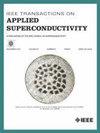用于高动态应用的 HTS 线性电动机的电磁-热分析
IF 1.7
3区 物理与天体物理
Q3 ENGINEERING, ELECTRICAL & ELECTRONIC
引用次数: 0
摘要
本文章由计算机程序翻译,如有差异,请以英文原文为准。
Electromagnetic-Thermal Analysis of an HTS Linear Motor for High-Dynamic Applications
This article presents and applies an electromagnetic-thermal model to design a double-sided coreless, conduction-cooled high temperature-superconductor (HTS) linear motor for a high-dynamic motion application, and assesses the thermal stability of the superconducting coils for continuous long term operation. The analysed motor topology contains stationary DC operated superconducting coils and conventional three-phase AC commutated mover-coils. The stator is a vacuum chamber which houses a cryogenic assembly containing the superconducting coils. The framework utilizes three computationally efficient models: a two-dimensional finite-element-method (2D FEM) model to evaluate the feasibility of superconducting coils under static conditions, a semi-analytical model to compute the motor thrust and eddy-current losses in electrically conductive structures of the cryostat during dynamic motion, and a 2D FEM full-scale model of the linear motor for overall loss calculation in the stator. The motor design, optimized for minimum volume, and an operating temperature of 20 K, produces a peak magnetic flux density of 5.43 T in the air gap in static conditions which results in a force density of 4700 kN/m3. Results show that steady-state temperature in the superconducting coils does not exceed 25 K. As such, the dynamic losses do not result in quenching of superconducting coils. This paper shows that a reliable operation of superconducting coils during high-dynamic motion condition is feasible.
求助全文
通过发布文献求助,成功后即可免费获取论文全文。
去求助
来源期刊

IEEE Transactions on Applied Superconductivity
工程技术-工程:电子与电气
CiteScore
3.50
自引率
33.30%
发文量
650
审稿时长
2.3 months
期刊介绍:
IEEE Transactions on Applied Superconductivity (TAS) contains articles on the applications of superconductivity and other relevant technology. Electronic applications include analog and digital circuits employing thin films and active devices such as Josephson junctions. Large scale applications include magnets for power applications such as motors and generators, for magnetic resonance, for accelerators, and cable applications such as power transmission.
 求助内容:
求助内容: 应助结果提醒方式:
应助结果提醒方式:


